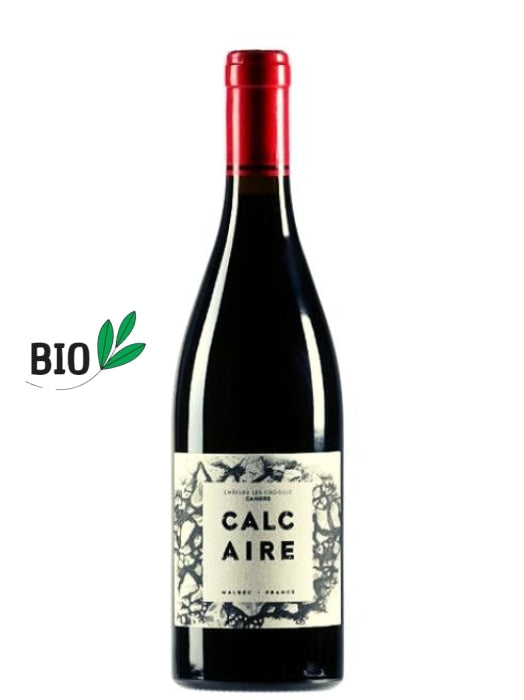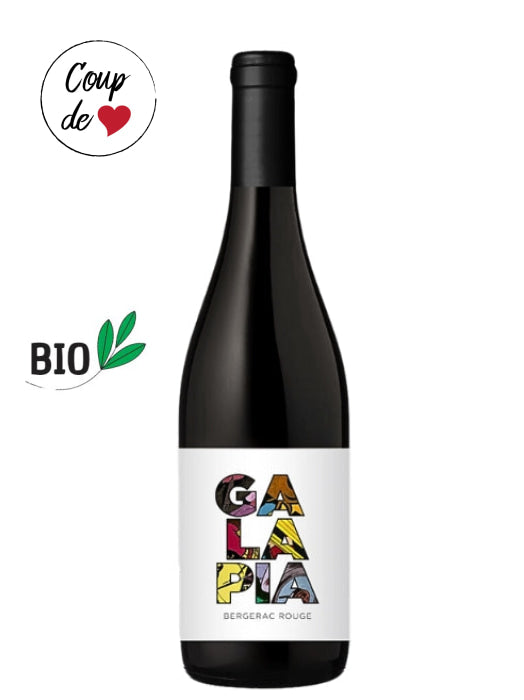Collection: Buy organic red wines
-
Bernard Fleuriet & Fils - Sancerre - Anthocyane rouge 2022
(3 avis)Usual price 30,90€Usual priceUnit price / par -
Bernard Fleuriet & Fils - Sancerre - Tradition rouge 2022
(3 avis)Usual price 20,90€Usual priceUnit price / par -
Château de Beaucastel - Châteauneuf-du-Pape rouge 2022
Usual price 98,90€Usual priceUnit price / par -
Château de L'Ou - IGP Côtes Catalanes - Infiniment rouge 2020
(2 avis)Usual price 25,50€Usual priceUnit price / par -
Château de L'Ou - IGP Côtes Catalanes - Secret de schistes rouge 2020
(1 avis)Usual price 34,90€Usual priceUnit price / par -
Château de la Selve - IGP Coteaux de l'Ardèche - Beaulieu (amphore) 2021
(2 avis)Usual price 16,50€Usual priceUnit price / par -
Château de la Selve - IGP Coteaux de l'Ardèche - Berty 2022
(2 avis)Usual price 21,50€Usual priceUnit price / par -
Château de la Selve - IGP Coteaux de l'Ardèche - Petite Selve rouge 2023
(2 avis)Usual price 11,90€Usual priceUnit price / par -
Château de Valois - Pomerol - Magnum
Usual price 63,90€Usual priceUnit price / par -
Château de Valois - Pomerol 2019
(3 avis)Usual price 32,90€Usual priceUnit price / par -
Château Les Croisille - Cahors - Calcaire
(2 avis)Usual price 15,90€Usual priceUnit price / par -
Château Les Croisille - Cahors - Croizillon 2022
(2 avis)Usual price 10,90€Usual priceUnit price / par -
Château Les Croisille - Cahors - La Pierre 2023
(2 avis)Usual price 23,50€Usual priceUnit price / par -
Château Les Croisille - Cahors - Silice 2022
Usual price 15,50€Usual priceUnit price / par -
Château Leydet-Valentin - Saint-Emilion Grand Cru 2020
(3 avis)Usual price 24,90€Usual priceUnit price / par -
Château Leydet-Valentin - Saint-Emilion Grand Cru 2020 - Magnum
Usual price 49,90€Usual priceUnit price / par -
Château Mille Roses - Haut-Médoc 2019
Usual price 21,00€Usual priceUnit price / par -
Château Mille Roses - Haut-Médoc Magnum 2020
Usual price 43,00€Usual priceUnit price / par -
Château Mille Roses - Margaux 2020
(3 avis)Usual price 31,50€Usual priceUnit price / par -
Château Pontet-Canet - Pauillac - 5ème Grand Cru Classé - Rouge 2017
Usual price 120,90€Usual priceUnit price / par -
Château Sainte-Marguerite - Côtes-de-Provence - Fantastique rouge 2021
(1 avis)Usual price 37,90€Usual priceUnit price / par -
Clos des Quarterons Domaine Amirault - Saint-Nicolas-de-Bourgueil - Le Fondis 2017
Usual price 20,50€Usual priceUnit price / par -
Clos des Quarterons Domaine Amirault - Saint-Nicolas-de-Bourgueil - Le Vau Renou 2019
Usual price 27,00€Usual priceUnit price / par -
Domaine Albert de Conti - Bergerac - Galapia 2024
(2 avis)Usual price 10,90€Usual priceUnit price / par
Organic red wines
Organic viticulture has seen significant growth in recent years in France, reflecting a growing consumer awareness. With a constantly increasing area, organic farming is indeed gaining popularity, not only for its environmental benefits but also for the intrinsic qualities it imparts to the wines.
Organic wines in France
With nearly 20% of the vineyard managed under organic farming, or about 150,000 hectares, France is at the forefront in the field of organic viticulture.
Our country indeed shows a significant commitment to this environmentally friendly practice. The regions most advanced in this approach include Alsace, Provence, Corsica, Languedoc-Roussillon and the Loire, benefiting from climatic conditions favorable to the organic cultivation of vines.
The making of a red wine
Before exploring the principles of organic farming, it is essential to understand the process of making a red wine.
It all begins with the harvest of grapes at optimal ripeness.
Once harvested, the grapes undergo a crushing process, crushing the berries to release the juice.
This juice is then placed in a vat to proceed with fermentation, during which the yeasts transform the sugar into alcohol. During fermentation, the grape skins remain in contact with the juice to extract pigments (anthocyanins), tannins, and aromas.
After fermentation, the produced wine is pressed with the skins and then transferred into the container where it will undergo its aging. This can be in a stainless steel tank, a concrete tank, or oak barrels. In the latter, it will develop new aromatic characteristics (woody, vanilla, spices, etc.)
Finally, once the winemaker deems the wine ready for consumption, it is then bottled and sold on the market.
Organic wine, biodynamic wine, natural wine, what are the differences ?
The principles of organic farming
Organic farming is based on principles aimed at minimizing the environmental impact of humans while promoting biodiversity and soil health.
Certified organic farming estates therefore cultivate their vines without using synthetic chemical pesticides, herbicides, or fertilizers. They therefore favor alternative methods such as the use of cover crops (green manure) or soil fertilization through composting.
Furthermore, during winemaking, only certified organic inputs are allowed.
Finally, the maximum allowed doses of sulfites are also lower for an organic wine compared to a conventional wine (150mg/L versus 100mg/L for an organic red wine).
The principles of biodynamic agriculture
Biodynamics goes further than organic farming by adopting a holistic approach, integrating practices based on natural rhythms and cosmic forces. Inspired by the teachings of Rudolf Steiner, biodynamics considers the vine as a living organism, interacting with its environment.
Biodynamic practices therefore include the use of natural preparations made from plants and minerals (cow dung, nettle, dandelion, etc.).), the observation of lunar and planetary cycles, as well as respecting cosmic rhythms in viticultural work. The goal of the biodynamic approach is to enhance the vitality of the soil, the vines, and thus the expression of the terroir in the wine.
Moreover, compared to organic farming, the winemaking process is even less interventionist. Thus, the number of inputs usable by winemakers is much more restricted, and the maximum allowed doses of sulfites in wines are lower (70 to 80mg/L maximum for red wines).
To date, about 1% of the French vineyard area is cultivated biodynamically. The two organizations certifying biodynamic agriculture are DEMETER and BIODYVIN.
Natural wines
Natural wines are distinguished by their minimalism in terms of human interventions, whether in the vineyard or the cellar.
Unlike biodynamics and organic farming, where certain inputs are allowed, even in small doses, natural wines are vinified without any addition of oenological additives. Natural winemakers therefore favor spontaneous fermentations, avoid excessive filtration and clarification, and minimize the use of sulfites (the addition is allowed up to 30mg/L for a red wine). Some winemakers even decide to do without it completely !
Proponents of the natural method aim to preserve the authenticity of the wine, faithfully reflecting the terroir on which it was produced, as well as the vintage.
The craze for organic wines
The growing demand for organic, biodynamic, and natural wines can be explained by several factors.
First of all, consumers are increasingly concerned about their health and the environment, seeking products from sustainable and respectful practices. Organic, biodynamic, and natural wines thus partly offer a solution to this issue.
Moreover, organic wines in the broad sense of the term are often perceived as being of higher quality, reflecting the purity of the terroir and the authentic expression of the grape variety.
Finally, the reduction of sulfites also addresses the concerns of consumers suffering from allergies or intolerances to SO2, thus offering a more natural and healthy tasting experience.
In conclusion, organic red wines, whether produced according to the principles of organic, biodynamic, or natural farming, embody the present and future of viticulture. By meeting consumer expectations in terms of health, environment, and taste quality, these cultivation methods contribute to the preservation of wine-growing ecosystems as well as the promotion of a more conscious and responsible lifestyle.
-

Conventional, organic, biodynamic, natural wine...
Here is a question that comes up (very) regularly! It must be said that the proliferation of labels does not really help the consumer to find their way... AB, HVE,...
1 commentConventional, organic, biodynamic, natural wine...
Here is a question that comes up (very) regularly! It must be said that the proliferation of labels does not really help the consumer to find their way... AB, HVE,...
1 comment -

The red wine guide
The world of red wine can sometimes seem vast and complex for the novice. Indeed, its spectrum is particularly rich: from smooth red wine to powerful red wine and even oaky red...
The red wine guide
The world of red wine can sometimes seem vast and complex for the novice. Indeed, its spectrum is particularly rich: from smooth red wine to powerful red wine and even oaky red...
-

The main red wine grape varieties
There are in the world more than 6,000 grape varieties. However, only a handful of them are actually used to produce the vast majority of the red wines we know. Throughout this article,...
The main red wine grape varieties
There are in the world more than 6,000 grape varieties. However, only a handful of them are actually used to produce the vast majority of the red wines we know. Throughout this article,...
-

The Bordeaux wine guide
Bordeaux is probably the region with the greatest wine reputation in the world (come on, along with Burgundy to be fair). And while the number of grape varieties, appellations and...
The Bordeaux wine guide
Bordeaux is probably the region with the greatest wine reputation in the world (come on, along with Burgundy to be fair). And while the number of grape varieties, appellations and...
-
✔️ 100% OF THE WINES TASTED
-
📦 FAST AND SECURE SHIPMENTS
-
🍷 IDEAL CONSERVATION
-
💳 100% SECURE PAYMENTS




























